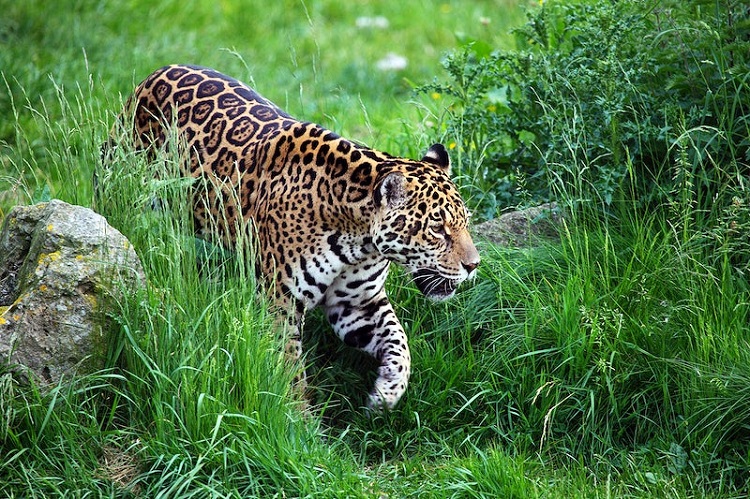The jaguar, the largest cat in the Americas, is a chunky boy with massive murder mittens, but even that wouldn’t stop us from wanting to give it a squeeze if we could.
It is a majestic cat with natural eyeliner (maybe it’s Maybelline?) and impeccable style.
The jaguar is also in danger of extinction, as we systematically threaten the forests they live in.
Find out more about why we need to continue our conservation efforts to protect this lovely wild beast.
Etymology of Jaguar
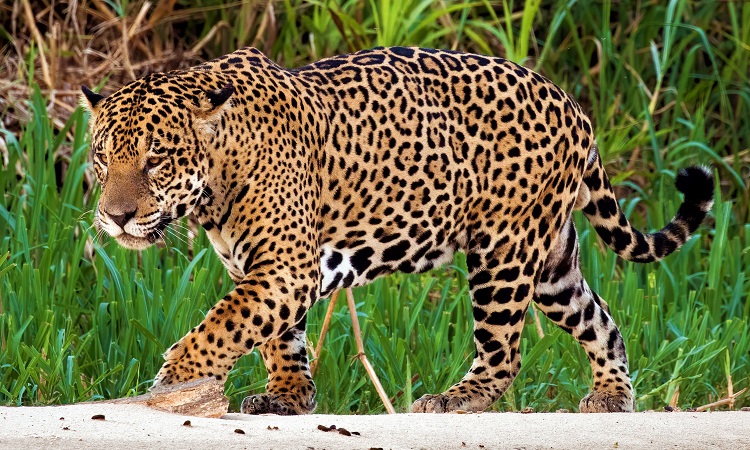
The word “jaguar” is thought to be derived from the Tupí-Guaraní language, a native dialect for people in Central and Southern Americas. They call the jaguar “yaguara,” which means “he who kills with one leap.” This is an apt description, as the jaguar has a more powerful bite than any other big cat.
Thanks to this extra jaw strength, they have an unusual killing technique that is quite effective: a powerful bite that pierces the back of the skull. Other big cats typically bite the neck or throat of their prey, a much softer and more vulnerable target.
Its scientific name is the Panthera onca. Panthera came from classic Latin and was originally used to describe all spotted cats until Reginald Innes Pocock revised the genus classification to include tigers, lions, jaguars, and leopards on the basis of cranial features.
Onca is derived from the Portuguese word “onça,” which they use to describe any spotted cat larger than a lynx.
What Does a Jaguar Look Like?
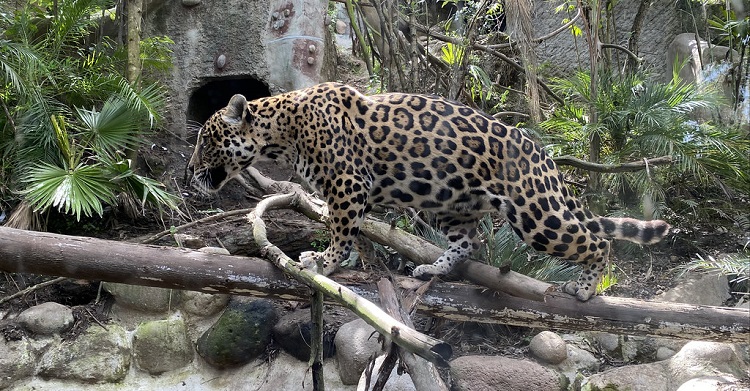
There’s a reason why jaguars have been the target of poaching for hundreds of years: their coat is gorgeous. These pretty kitties are usually pale yellow with black and brown spots and rosettes covering their backs, sides, and tail. Rosettes are irregular circles of black coloration, usually with a darker tan/orangey-brown inside.
Rarer but equally beautiful, melanistic jaguars have the same patterns in their fur but appear to have a solid black coat. (You can only see the rosettes when up close, and honestly, you should never be that close to a wild jaguar.)
Their faces are beautiful, with white, orange, brown, and black markings that are unique for each individual jaguar.
The jaguar is also the chunkiest of the big cats, but that doesn’t mean they’re unhealthy. Their square heads and stockier limbs are stacked with muscles, which is what makes them such efficient killers.
Taxonomy and Evolution
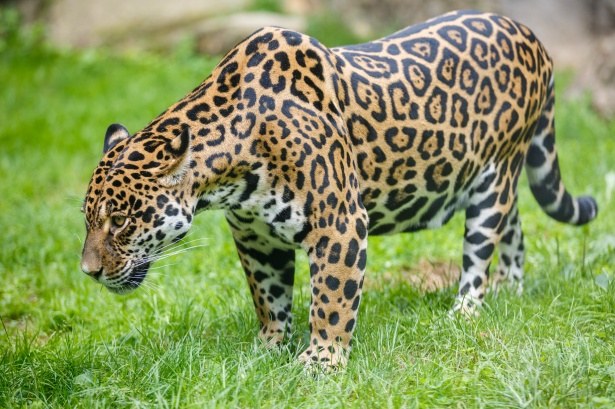
Let’s delve deeper into their history and background to understand how they evolved.
Scientific Classification
Scientists are still fighting over whether the jaguar is genetically closer to a lion or a leopard within the Panthera species. If you base the argument on nuclear DNA, then a jaguar is genetically closer to a lion.
But if you compare their mitochondrial DNA, the leopard is closer to a lion, and the jaguar has to move down the phylogenetic relationship tree to be between snow leopards and tigers.
Subspecies
The jaguar is an example of a “monotypic taxon.” That’s a really fancy way of saying: they don’t have subspecies. They’re one of a kind… taxonomically, at least. There are, however, four geographic groups that differ from each other based on where they live.
Jaguars in Mexico and Guatemala are slightly different from those in southern Central America, and those are a bit different from the ones in northern South America, and there’s another group further south on that continent.
There are two extinct subspecies, however: P.O. Augusta in North America and P.O. Mesembrina in South America.
Color Variation
Although most jaguars have that yellowish-tan base color fur, there is a broad spectrum of base colors they can have, from white to black. There are always rosettes with a spot in the middle along their sides, but in the dark brown and black jaguar, they may just be difficult to distinguish.
Where Does the Jaguar Live?
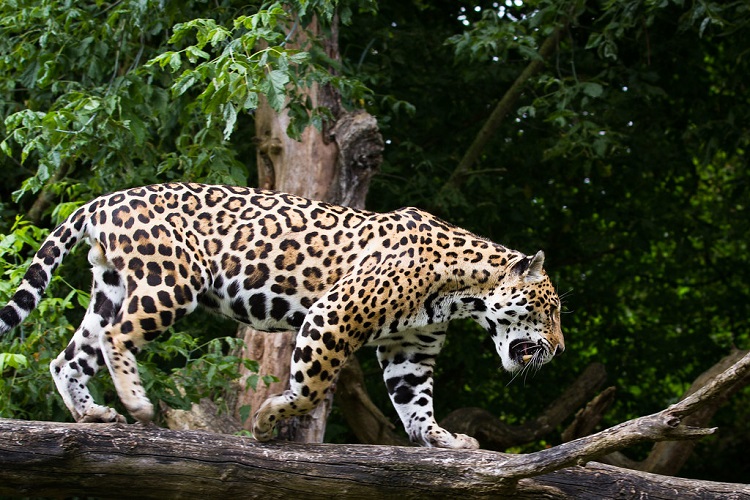
Jaguars prefer to live in dense, tropical rainforest habitats –particularly in the Amazon rainforest — but they are also found in savannas and grasslands. Seeing as those terrains aren’t exactly similar, it shows just how agile and adaptable the jaguar can be.
They are just as good at traversing large rivers and lakes as they are at climbing trees – whatever it takes to hunt and catch their prey.
The jaguar’s historic range has been greatly diminished. At the beginning of the 20th century, the jaguar’s distribution ranged from the southern United States through Central America and into southern Argentina.
But over the next hundred years, their range shrunk by approximately half, mainly in a north-to-southwards descending direction. Today, the southern United States might glimpse an individual within its borders, but their numbers are vastly reduced.
Behavior and Ecology
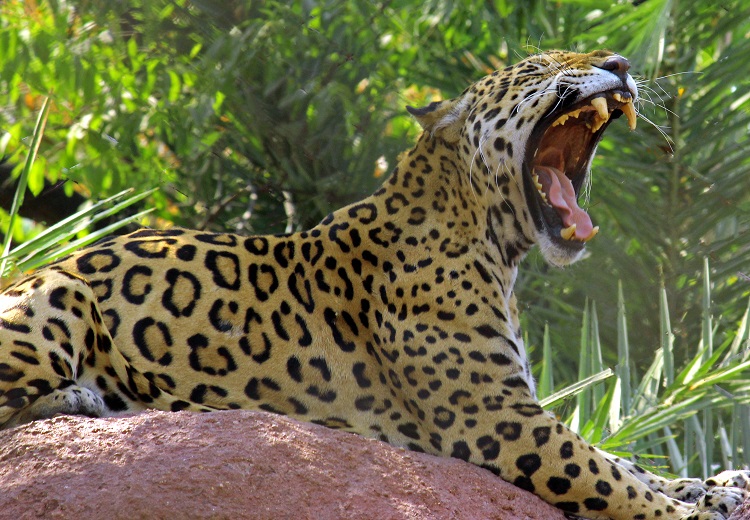
Read about the various behaviors and relationships of jaguars with others.
Ecological Role
Jaguars have the honor of being apex predators. That means that in addition to being really cool, they don’t have anyone above them on the food chain.
Jaguars Hunting Technique and Diet
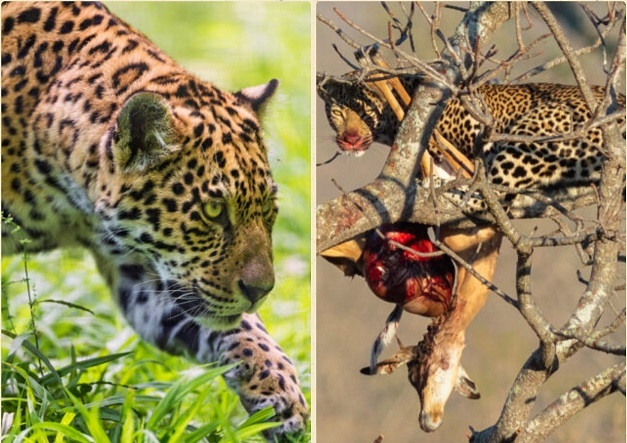
Jaguars are mostly nocturnal, doing the majority of their activity at dusk and through the night. Like some other cats, in the back of their eyes, they have a mirror-like structure called the tapetum lucidum, which reflects light back into the retina.
This nearly doubles the jaguar’s ability to see at night and in low light, which is a massive hunting advantage. The jaguars that live in really densely wooded regions, like tropical rainforests, will be active during the day, however, using the shadows for camouflage instead of twilight.
When they are awake is usually dependent on when their prey is awake, which just makes a ton of sense.
Jaguars are opportunistic hunters and will eat just about anything they can bring down. They first stalk and ambush their wild prey and then use their powerful bite to pierce the back of the skull, bringing it down instantly.
They prefer to hunt larger prey when they can, like capybaras, tapirs, and giant anteaters. They’ll also go for marsh deer, southern tamandua, collared peccary, and black agouti.
They are very good swimmers, so they won’t hesitate in chasing prey like reptiles or even fish. The jaguar is one of the only big cats that can pierce through the carapace of turtles and tortoises, and they’re known to munch on caimans as well. They can also climb trees, so it’s not unheard of to see a jaguar gnawing on a bird, as well.
Social Activity
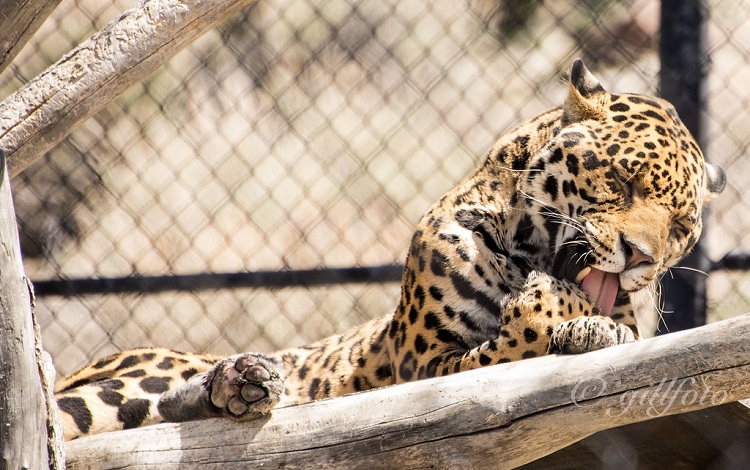
The jaguar is a solitary animal, for the most part. Female jaguars will keep their cubs with them for up to two years, however, and sometimes males will team up to protect a common territory and mates, but not often.
They are also territorial, using their urine, feces, and claw marks to define their turf. Males prefer to avoid rival males rather than challenge them to a fight, although that does happen occasionally.
What’s really cool is jaguars use a land tenure system, meaning females establish overlapping home ranges, and female offspring may “inherit” land from their mothers. (Damn the patriarchy!)
Males tend to establish territories twice as large as females (oh, of course) which might overlap the ranges of several females.
Reproduction and Life Cycle
Northern populations of jaguars mate towards the end of the year, but the South American jaguars don’t seem limited to any particular breeding season.
Breeding pairs typically stay together for about five days, and then they go their own ways. (This is just fine because male jaguars are dead-beat dads. They have been known to eat their own young, so the mom doesn’t want them around, anyway.)
After a gestation period of approximately 100 days, the female jaguar usually gives birth to one to four impossibly adorable cubs. The cubs are born with spots (aww!) and blind, as they don’t open their eyes for their first two weeks of life.
Cubs are weaned after about three months but will stay in the birth den with their mother for about six months, after which they will start to accompany her on hunting trips. By about 15 months of age, the cubs are capable of hunting on their own, but they typically stay with their mother until the age of two.
Then, they go off and claim their own territory, which may or may not overlap with their mothers’. Girl jaguars reach sexual maturity at the age of 2.5 years, and the male jaguar is usually sexually mature at the age of 3.
Attacks on Humans
When cornered, a jaguar is a savage fighter, but jaguar attacks on humans are pretty rare. We’re just not meaty enough – it’d be a waste of energy to take us down.
Threats to Survival
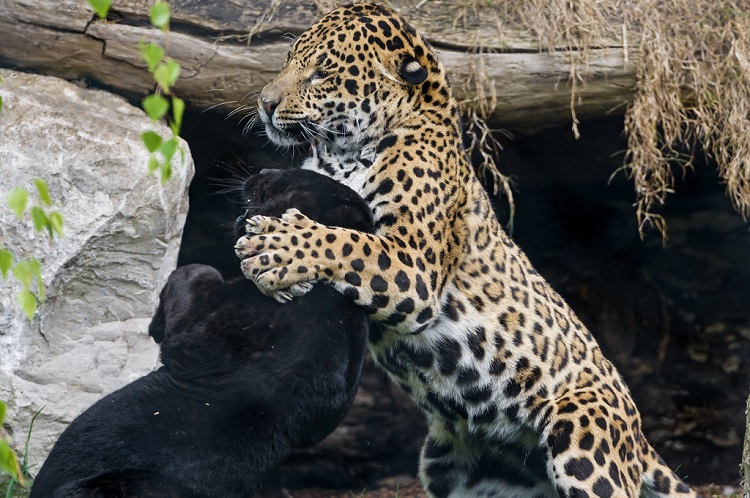
One of the jaguar’s biggest threats to survival is habitat loss and fragmentation. Logging and deforestation for industrial agriculture are major culprits, as demand for soy, palm oil, and acreage for cattle ranching continues to soar.
As their habitat diminishes, so do their prey sources. For example, the white-lipped peccary, one of the jaguar’s preferred sources of food, has disappeared from 87% of their historical range in Mesoamerica.
As their ecosystems are systematically destroyed, their populations become more isolated, which diminishes the exchange of genetic material and further threatens their future existence.
Jaguars also face the threat of illegal trade. The demand for their fur has thankfully diminished since the 1970s (although some animals are still killed for their beautiful pelts), but they are also hunted for their body parts (teeth) for traditional medicine and ornaments, as well as by sport hunters.
Finally, jaguars are also killed by ranchers because they are perceived as a threat to their livestock. Retaliatory killings are relatively common, in which ranchers go out and shoot the nearest predator they consider responsible for any attacks.
Facts About Jaguars
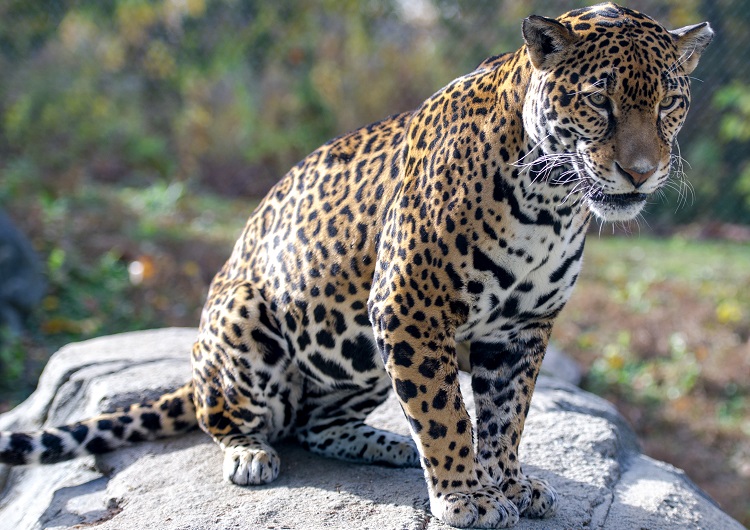
- The jaguar is the least likely species of big cat to kill or eat humans. The only recorded attacks have occurred when a jaguar has been cornered or wounded.
- Both male and female jaguars roar or grunt as a form of long-distance communication, usually when they want to mate. (It’s like the jaguar version of a booty call.)
- Their more common sound is called a ‘saw’ because it sounds just like the sound of sawing wood… if the saw was only moving in one direction. And when they’re happy to see each other, they will ‘chuff,’ which is a nasal, snuffling sound.
- The oldest known jaguar lived to be over 29 years old. She was named Micica and was a resident of Zoo Osijek in Slavonia, Croatia.
Conservation Status
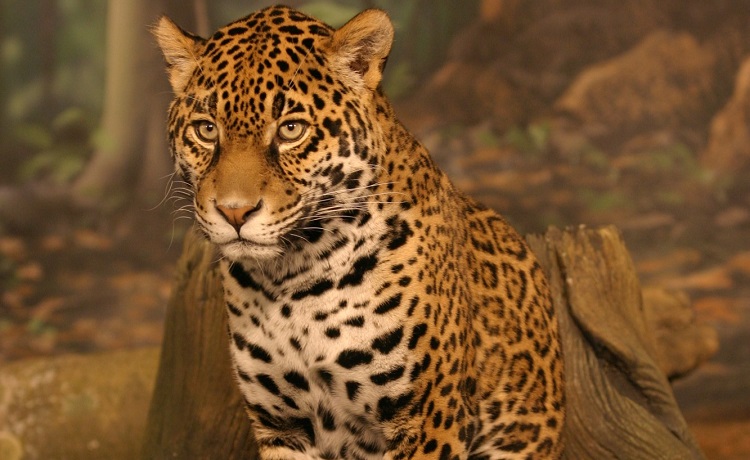
The jaguar is listed as “Near Threatened” by the IUCN Red List (International Union for Conservation of Nature). This category is used for animals who do not qualify for the endangered species status but are considered likely to qualify in the near future.
They are also listed in CITES Appendix 1, the legislative resolution adopted during the Convention on International Trade in Endangered Species of Wild Fauna and Flora. This is a multilateral treaty to protect endangered plants and animals from the threats of international trade, which first enforced in 1973.
Appendix 1 is the highest level of protection the legislation offers, which makes all international trade in jaguars or their body parts prohibited.
Jaguar Conservation Units
JCUs, are designated priority areas for jaguar conservation. In 1999, field scientists set out to establish areas of land that contained at least 50 breeding pairs of jaguars to focus their conservation efforts on.
As a result, 51 JCUs were designated, spreading over 36 geographic regions extending from Mexico to Argentina. The most well-known is the Cockscomb Basin Wildlife Sanctuary in Belize.
Established in 1986, it was the first protected area for the jaguar species. They also determined optimal routes of travel between these jaguar populations so that they could try to implement wildlife corridors that could also be protected.
Approaches
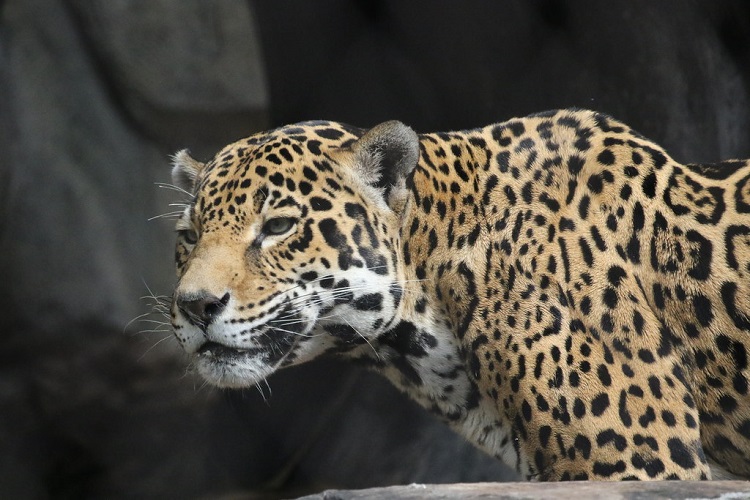
So far, the JCU approach has seen some promising results. Since their conservation strategy was implemented in 2005, Mexico has seen an estimated population increase from about 4,000 individuals in 2010 to about 4,800 in 2018.
One way these results are measured is using camera trapping (i.e., wildlife cameras set up in strategic locations to “trap” images of jaguars. No actual traps are involved.) They also use wildlife tracking telemetry to try and monitor known individual jaguars and their territories. Scientists also love to analyze poop: they have detection dogs that sniff out jaguar feces in order to analyze their health and diet.
A newer method that conservationists are encouraging is promoting ecotourism. They want to generate more public interest in animals on the decline so that more people will be invested in saving them, and thus engagement in broader conservation efforts will increase.
One crucial element of this approach is educating local ranchers about how to reduce human-jaguar conflict.
Workshops are being developed to teach better husbandry practices, and there are also programs designed to compensate ranchers when they lose cattle to jaguar predation, so they’re less likely to seek out and kill the cat in anticipation of a loss or retaliation.
Jaguars and Leopards the Same Animal?
Leopards are part of the same subfamily as jaguars — Pantherinae Panthera — but they are, in fact, a separate species: P. pardus. Jaguars and leopards are often mistaken for each other because they look a lot alike.
The easiest way to distinguish between the two is their markings: jaguars have black dots in the middle of some of their rosettes, but leopards do not. Jaguars are also stockier and generally more thick, with larger, square heads.
Do Black Jaguars Exist?
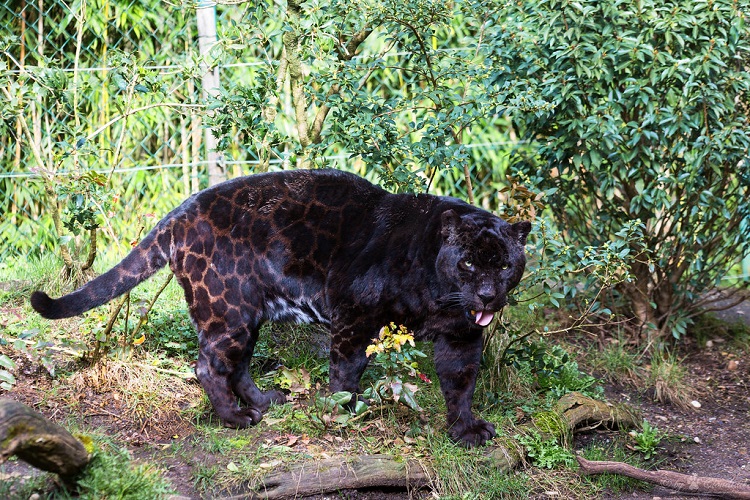
Black jaguars are actually melanistic jaguars, meaning they have an abundance of melanin (or black pigmentation), which is what gives skin and fur a darker appearance. So while these jaguars appear to be solid black, if you got closer, you would be able to observe faint rosettes and spots.
How do Jaguar’s Spots Differ From Those of Other Wild Cats?
Jaguars are the only big cats that have black spots in the middle of their rosettes.
In Culture and Mythology
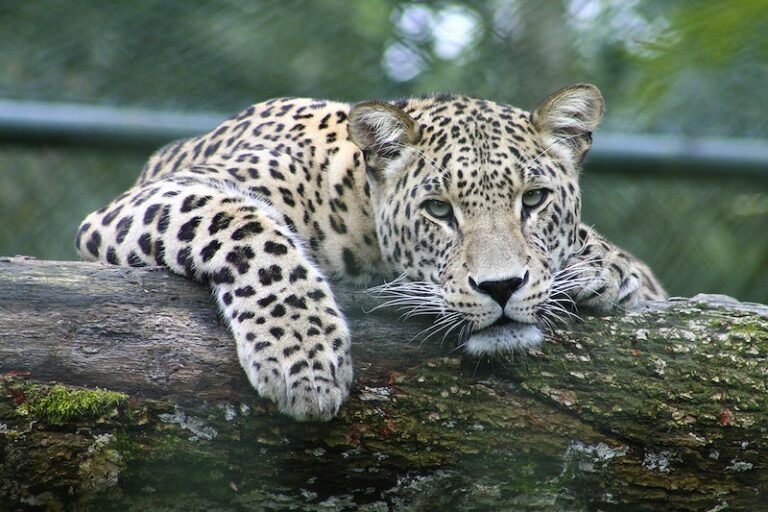
The jaguar has long been a sacred animal and a symbol of power and strength in Mesoamerica. Depictions of their ferocious faces have been found in ruins all along Mexico’s Yucatán Peninsula, where the jaguar was a prominent figure in Olmec, Mayan, and Aztec religious rites.
In fact, the Mayans believed that the jaguar, with its highly adaptable nature, was like a spiritual emissary, able to move between the living and spirit worlds. After all, the jaguar was at home in trees and in water, during the day and at night, and seemed to be otherworldly in all its graceful pursuits.
The jaguar was equally highly regarded amongst the Aztecs, but more for its warrior qualities. In their mythology, the jaguar was the totem animal of the powerful deity Tezcatlipoca, who was often depicted with black and yellow stripes across his face.
Their rulers are depicted in ceramics and paintings wearing jaguar skins, which were a symbol of royalty and power.
FAQ’s
Do Jaguars Live Longer Than the Average Domestic Cat?
Jaguars live for 12-15 years in the wild, which is the same approximate lifespan as that of the average house cat. In captivity, though, they can live almost ten years longer than that.
Can Jaguars Swim, and Do They Enjoy Doing So?
Jaguars are very good swimmers. Unlike other cats, they don’t avoid water at all – they are often found paddling in rivers and crossing strong currents without hesitation.
Do Jaguars Live in Africa?
Contrary to popular belief, jaguars do not live in Africa. People who claim they do are probably just confusing them with leopards.
Conclusion
Despite the fact that the jaguar population has seen a promising bounce back to less distressing numbers, a lot of work still needs to be done to protect this incredible creature.
Jaguars live in an environment that is constantly at risk thanks to illegal killing, logging, and habitat fragmentation.
It will take a concerted effort to protect their domain in Central and South America and to re-establish their former territory in the southwestern United States, but it can –and should — be done


